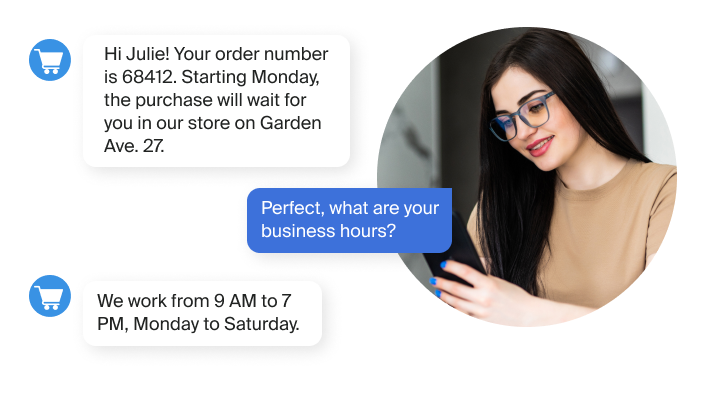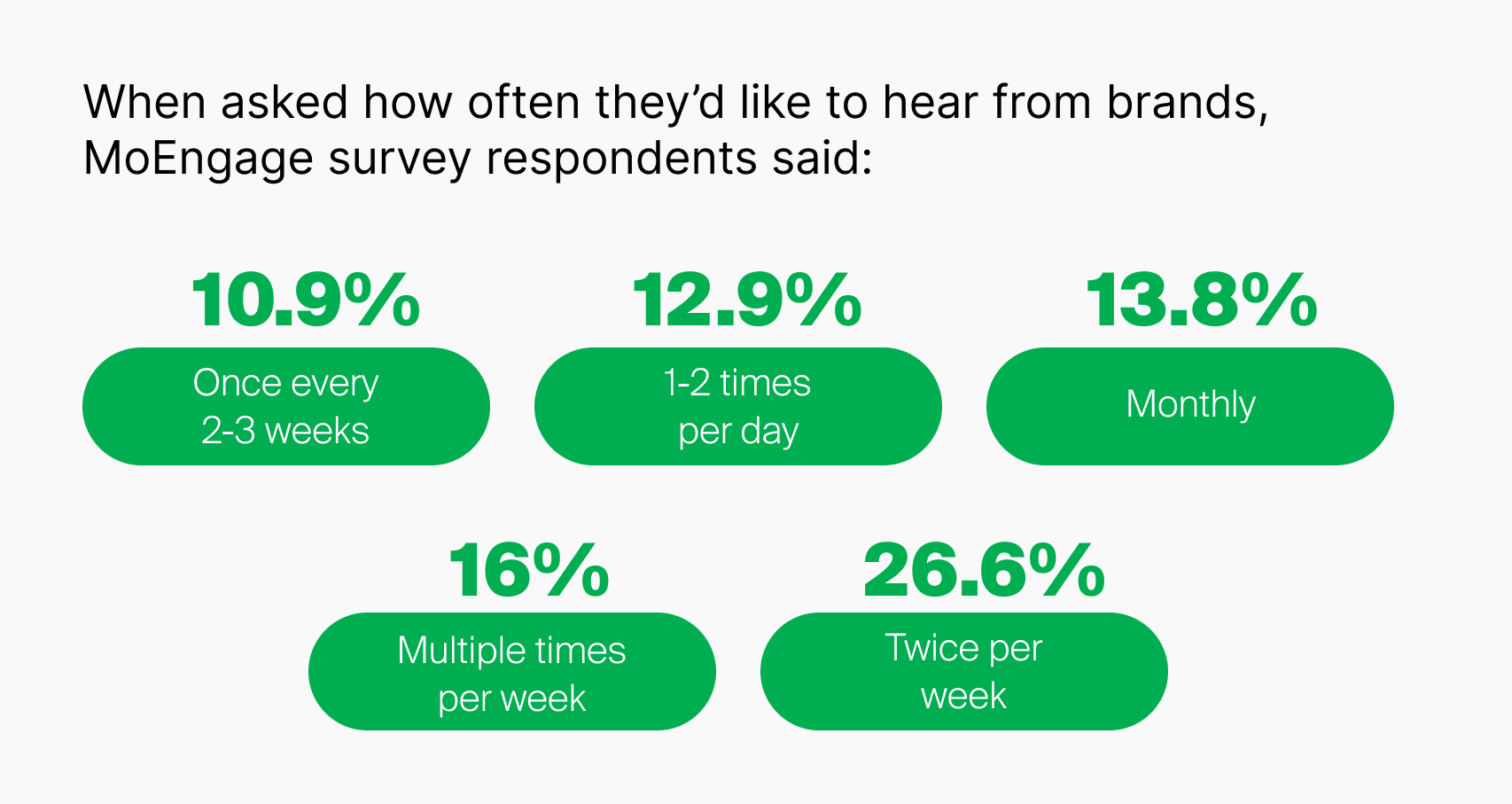When strategies to attract new buyers work like a charm, it’s easy to neglect retention rates and returning customer orders as equally important KPIs. If we consider the old business adage suggesting that 80% of a company’s profit usually comes from existing consumers, it’s clear that a lot is at stake if businesses neglect this segment.
This is particularly important considering the declining sense of loyalty demonstrated by modern consumers. In the 2023 report by Mirakl, only 17% of consumers said they’d continue to buy from their favourite brand regardless of the price. Instead, 89% say that value is playing an increasingly important role, while 43% stopped shopping with specific retailers because of rising prices.
Suggested read: Conversational Marketing Insights
Furthermore, analysing online store experiences, a 2023 Konigle study found that only 20% return for a second purchase, 8.1% for a third, and 4.3% for a fourth.
So, what makes consumers come back? And why should e-commerce and retail businesses put more effort into re-converting one-time buyers?
In this article, we’ll look into some economic principles and factors helping improve repeat purchase rates.
What is the actual value of repeat buyers?

The 80-20% Pareto Principle has brought existing customers into the spotlight of the business world, but another research offered an insight into how this affects profits. Fred Reichheld of Bain & Company, who also invented the Net Promoter Score (NPS), suggested that a 5% increase in customer retention can produce more than a 25% increase in profit. This was a while ago, and a lot has changed since then, but the focus on current and repeat customers is still considered vital for business success.
In the SaaS industry, businesses with retention rates of 85% grow up to 3x faster. In retail, existing customers ordered 3% more compared to last year and 16% more than in 2021, as suggested by Salesforce. Here, Salesforce quotes Neiman Marcus as a brand that generates 40% of its annual revenue from only 2% of its customer base.
Of course, these rates will vary by industry, as revealed by SurveySparrow:
- Insurance: 84%
- Retail: 63%
- Banking: 75%
- SaaS: 35%
- Hospitality: 55%
- Media: 25%
- Fintech: 37%
- Edtech: 4%
These figures help businesses establish benchmarks for their own strategies and increase focus on the most valuable segment of their audience. In addition to securing consistent profit, loyalty is critical for increasing word-of-mouth marketing, brand evangelism, and overall sentiment improvement, which add uncountable value to business operations.
How to measure retention rates
Measuring the retention rate can be as simple as comparing the number of extensions in subscription-based solutions or as complex as calculating CLV in a B2B enterprise setting. One of the widely accepted formulas is:
Customer retention = Number of paying customers from last year [Divided by] Number of paying customer a year ago
Salesforce offers the following alternative:
CRR = ((E-N)/S) x 100
CRR – customer retention rate
E – customers you have at the end
S – customers you have at the start
N – customers you acquired during the period of measuring
For example, if you had 100 paying customers last year and only 50 of them are still with you, your retention rate is 50%. This is a largely simplified equation, but even the very focus on it can help you discover trends that might bring you significant profit. For example, if you identify that the number of your repeat buyers is declining year over year, this might indicate that customers might not like your products well enough to buy again. It may also imply the changing audience profiles interested in what you are offering. Whatever the case, by focusing on retention rates, you can develop highly effective profit growth strategies.
5 Conversational commerce actions to re-engage one-time buyers
The changing world of e-commerce requires sophisticated strategies to re-engage the one-time buyer who is likely distracted by dozens of competitive offers. Digital consumers now consider their overall experiences before deciding to buy from or stay loyal to a brand. Your engagement and communication strategies are a big part of their experience as buyers now expect personalised communications and immediate responses anytime and via their preferred channels.
With that in mind, brands can put a conversational approach into play to re-engage one-time buyers in the following way.
1. Keep in touch – when it matters.
The growing digital fatigue is one of the critical factors shaping consumers’ readiness to engage with brands. They are increasingly feeling overwhelmed by the abundance of brand messages they’re receiving though ads, emails, SMS, etc. That’s why they now expect brands to hear from brands at the right time and via the channel they use and trust the most.
Research suggests they’re interested in hearing from brands twice a week and, ideally, with personalised offers and recommendations. Anything else can just be a cause of frustration and trigger their decision to never return.

2. Offer perks, gifts, and points.
Loyalty programs have always been one of the most effective ways to keep customers coming back. In the 2022 State of Brand Loyalty survey by Yotpo, 83% of consumers said such programs to at least some extent influence their decision to buy again from a brand.
By rewarding repeat buyers with loyalty incentives, you make them feel valued and appreciated. You can provide coupon codes for the next purchase in their favourite category, reward points for those who leave a positive review or gift cards for products and services they might like based on previous purchases. It is important to personalise these perks and also communicate them via consumers’ favourite channels.
3. Tailor consistent and exciting product experiences.
63% of consumers say it takes only one bad product information experience to cause them to give up on a brand. Moreover, 53% of buyers have returned a product due to incorrect pre-purchase information. Whatever the message you decide to communicate and promote to your customers, make sure it is not misleading. Make sure your product pages contain accurate details and FAQ sections providing information on order and return policies. This helps minimise returns and makes relevant information immediately available to consumers, rather than expecting them to browse your website or engage in support calls to discover them.
4. Make it personal to make it work.
Personalisation is an increasingly critical requirement of modern consumers. By providing relevant content and offers based on their past purchases and experiences, you make them feel valued and understood. Genesys considered personalisation experiences that customers value the most.
- 62% Receiving the services I need at any time in my preferred channel of choice
- 62% Being connected straightaway with the right person to help me
- 42% Being offered services and products that are customised to my needs
These findings help you tailor your re-engagement strategies to address the emerging needs of your current and potential customers. By segmenting your audiences based on interests and past purchasing behaviours, you can deliver relevant communications and create targeted promotional campaigns. When you deliver them via their favourite channel, they’re more likely to remain loyal and recommend your business.
5. Establish feedback loops and act on it.
While quantitative data on your customers’ behaviour may point you to specific trends and preferences, the only actual way to understand why they behave the way they behave is to ask them for feedback on their experience. Reaching out to them is easier than ever before with quick SMS polls or Viber surveys. WhatsApp is a good channel for these kinds of interactions too, as long as you make your surveys short and simple. The data you collect will provide valuable insight for all your teams – from marketing and support to sales and management.
6. Embrace new engagement technologies.
2/3 of consumers would become loyal if brands used engagement technologies to improve shopping experience. AI-powered chatbots, virtual shopping assistants, and visual configurators are some of the options that help influence them to buy repeatedly. AI chatbots can ensure 24/7 availability without having to hire additional support agents. Additionally, an engagement platform that integrates SMS, Push notifications, Viber, WhatsApp, and other critical communication channels is an increasing priority for brands looking to improve the visibility of their offers, humanise their communications, and provide more immediate responses

Conclusions
The first step to succeeding in one-time buyer re-engagement is to recognise their value and develop strategies to maximise it. The best practices outlined above can help you build more meaningful relationships with them and turn them into loyal buyers or even brand evangelists.

